2002 North Main Street
Santa Ana, California 92706
TEL: 714.567.3600
Who Answers the Cries: Guanyin at the Bowers
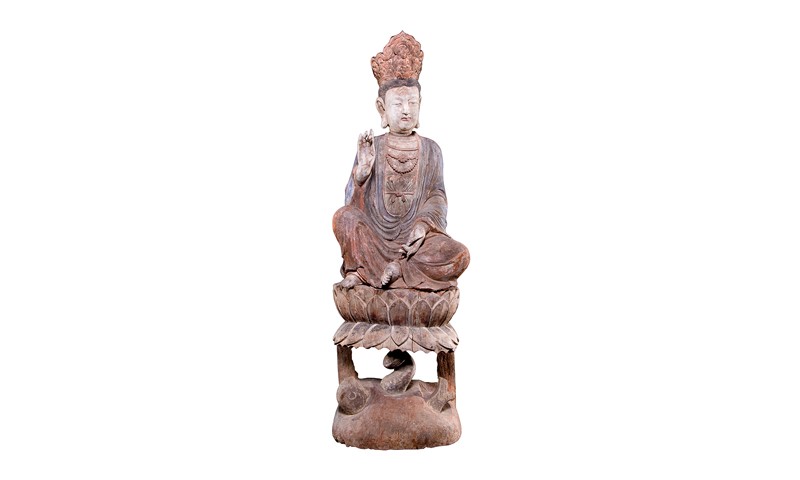 |
| Guanyin Seated on a Lotus Flower, late Ming Dynasty (1600-1643) Han culture; China Wood and pigments; 49 x 16 x 11 in. 2005.37.1 Gift of Anne and Long Shung Shih |
Mercy Me
Whether or not you recognize the name, if you have been to the Bowers you have seen at least one representation of Guanyin, the adopted Chinese bodhisattva and goddess of mercy. Wooden and marble sculptures depicting the figure can be found in the Bowers Museum’s main south lobby, in our Ancient Arts of China exhibition and in the Anne Shih garden, and each of these serves as important individual representations of the figure. This post examines these depictions of Guanyin, and looks at how the figure evolved from a male bodhisattva to a Chinese goddess.
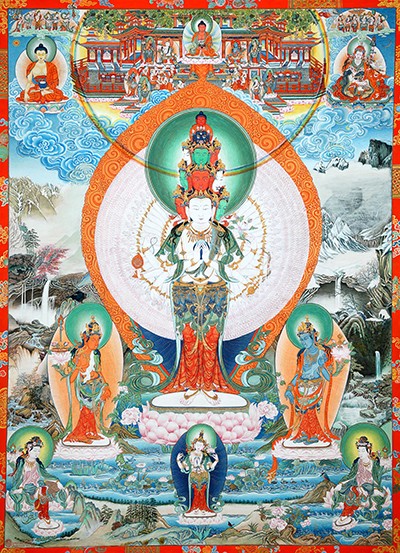 |
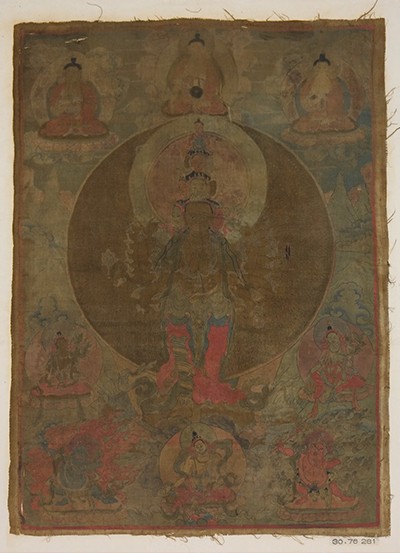 |
| Eleven-headed Avalokiteshvara with a Thousand Arms and Eyes, c. 2008 Shashi Dhoj; Tulachan, Nepal Natural mineral pigments L.2012.25.1 Loan courtesy of Gayle and Edward P. Roski |
Similar Panel from Painting of a Thousand-Armed Guanyin Metropolitan Museum of Art Collections |
Found in Translation
Guanyin can be first traced back to the bodhisattva Avalokiteśvara who appeared later on in the Lotus Sutra around the middle of the 2nd Century. In this first depiction Avalokiteśvara was already associated with mercy, directly responsible for transporting the dead from the land of the living to the Pure Land of the Amitaba Buddha. Here they were removed from the Wheel of Samsara allowing them to reach Nirvana or spiritual enlightenment in only one lifetime. The name Avalokiteśvara itself is Sanskrit for “one who looks down on the suffering of the world” and as an interesting side note, the Dalai Lama is considered by some to be the reincarnation of Avalokiteśvara. When Avalokiteśvara was introduced to China the name was translated to Guan-shi-yin which is a translation of the name’s meaning. Little was lost in the process of assimilating the figure into Chinese tradition. Guanyin is to this day understood to be a bodhisattva whose purpose is to help fellow man along the path to enlightenment. Even very specific forms exist in both Mahayana and Chinese Buddhism. The thangka painting in the Bowers' main lobby of Avalokiteśvara with 11 heads and 1000 arms—given by the Amitaba Buddha so the bodhisattva could better care for those in suffering—is one such example.
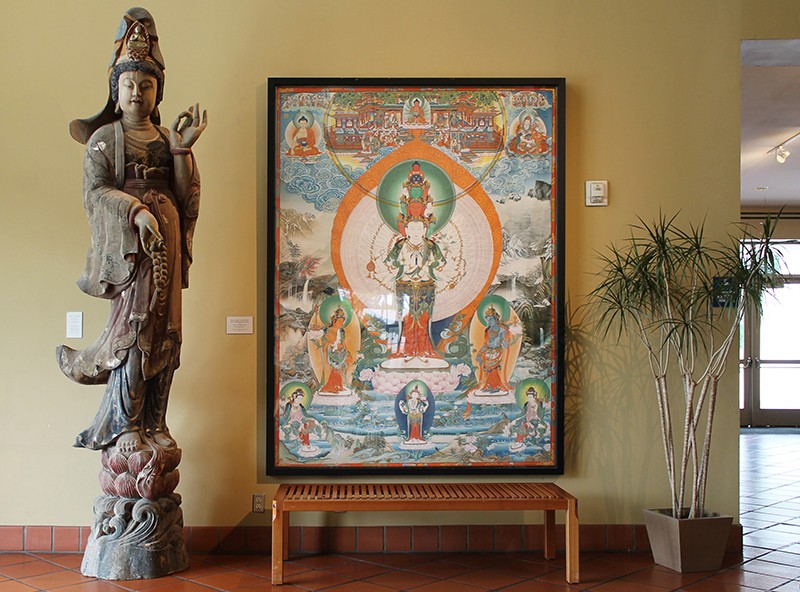 |
| Figure of Guanyin, early 20th Century Han people; Heibei province, China Wood and pigments L.2013.13.3 Loan courtesy of Gayle and Edward P. Roski |
Gender Fluidity
This same thangka of Avalokiteśvara painted by a Nepalese artist is positioned beside a tall sculpture of Guanyin. Avalokiteśvara is an interesting character in the Buddhist tradition because he is said to have 33 depictions, each of which was intended to be able to best heal people of their suffering, ignorance, and passion. Of these 33 depictions, 7 were female. When Guanyin was first adopted by Chinese culture in the 3rd Century it was primarily the male depictions which were transferred, but China—already with a pantheon of goddesses—was receptive to the female bodhisattva. Guanyin was first depicted as a female in China, likely concurring with the rising popularity of the Lotus Sutra as early as the Sui or Tang Dynasties (581-907). By China’s Ming Dynasty (1600-1643) most depictions of Guanyin in China were already female. The wooden sculpture of Guanyin seated on a lotus flower serves as an interesting counterexample to this rule, as it ought to be female based on the period during which it was made, but does not display many of the characteristic sexual characteristics of female depictions of Guanyin. Identification of the other sculptures has been difficult, but a key identifier is whether or not the chest is covered up to the breasts. We can see that this is only the case with the wooden sculpture in the main lobby.
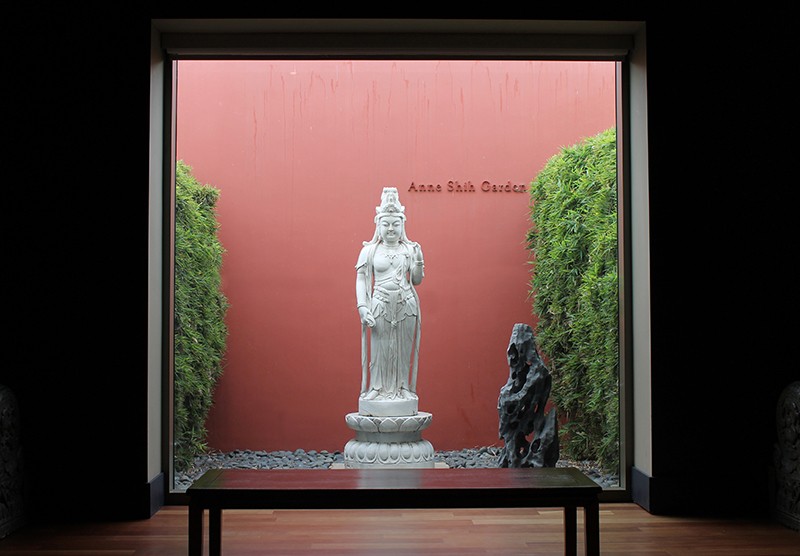 |
| Sculpture of Guanyin in the Anne Shih Garden. |
Promotion to Goddess
What is entirely more complex is the change of scope which Guanyin’s role underwent. Guanyin’s original duty was only to bring the recently deceased to the pure land of the Amitaba Buddha, but the idea of Guanyin as a savior figure resonated well in China. As the legends and parables surrounding Guanyin were restructured for their Chinese context, they took independent forms from those of the original sutra. Due in large part to the legend of Miao Shan, a female reincarnation of Guanyin from the 11th Century, along the coast the figure became a patron saint to fishermen who would pray to her before heading out to sea. The presence of a fish beneath Guanyin’s lotus flower in the wooden sculpture in our Ancient Arts of China exhibition can be explained by this. Her position on a white lotus flower is a symbol of purity which has become further codified just in the past two centuries by the female bodhisattva often wearing a white robe. In this newest form the line between bodhisattva and deity has blurred, the two now used interchangeably to discuss this important figure of salvation.
Text and images may be under copyright. Please contact Collection Department for permission to use. References are available on request. Information subject to change upon further research.

Comments 5
Wooden and marble sculptures depicting the figure can be found in the Bowers Museum’s main south lobby, in our Ancient Arts of China exhibition and in the Anne Shih garden, and each of these serves as important individual representations of the figure.
I live near the Bowers Museum. I'll have to check it out!
Is this still on display?
I was lucky enough to see this exhibition when I was last in Orange County, the photos do not do the exhibition justice - the level of detail in this artwork is amazing, true crafts at it's best, thanks for sharing